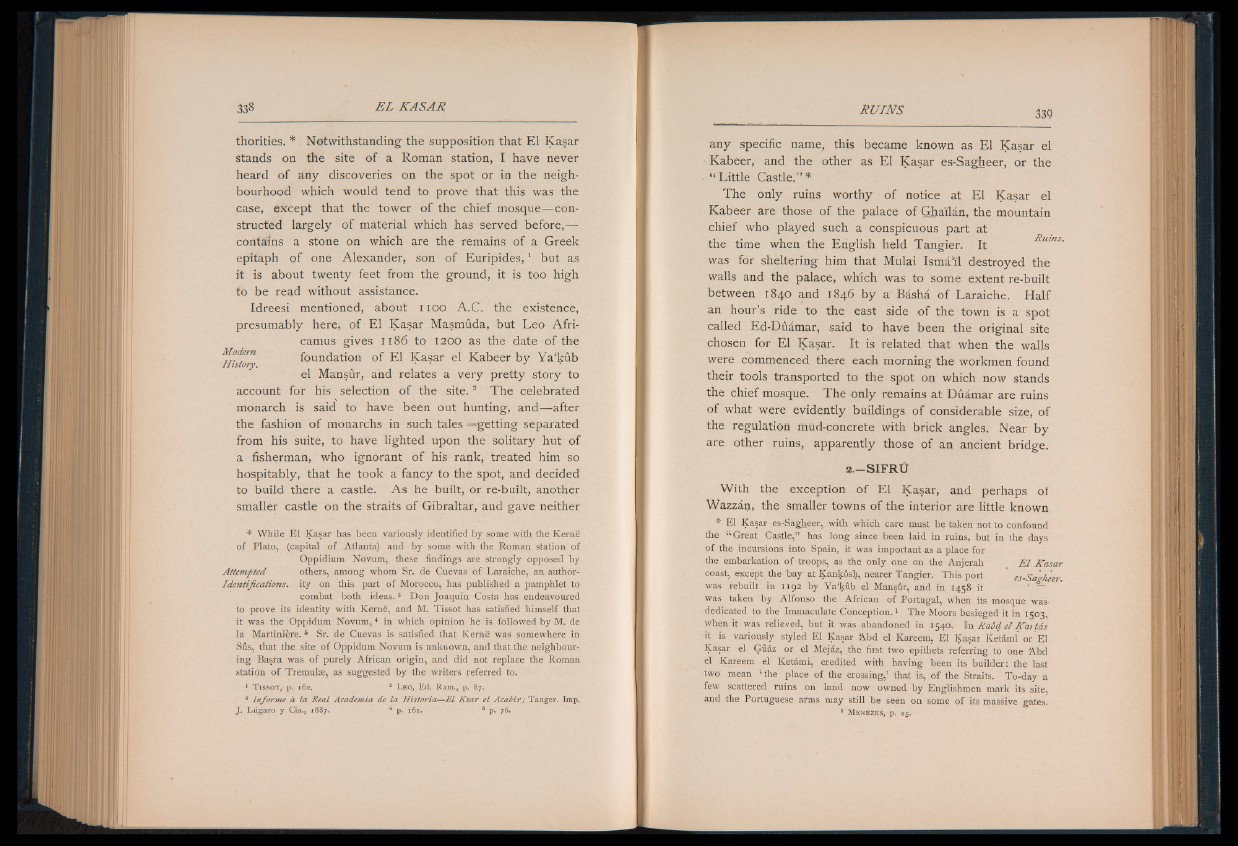
thorities. * Notwithstanding the supposition that El Kasar
stands on the site of a Roman station, I have never
heard of any discoveries on the spot or in the neighbourhood
which would tend to prove that this was the
case, except that the tower of the chief mosque— constructed
largely of material which has served before,—
contains a stone on which are the remains of a Greek
epitaph o f one Alexander, son of Euripides,1 but as
it is about twenty feet from the ground, it is too high
to be read without assistance.
Idreesi mentioned, about I xoo A.C. the existence,
presumably here, of El Kasar Masmuda, but Leo Africamus
gives 1 186 to 1200 as the date of the
Modern foundation of El Kasar el Kabeer by Y a ’kub History. * J
el Mansur, and relates a very pretty story to
account for his selection of the site.2 The celebrated
monarch is said to have been out hunting, and— after
the fashion of monarchs in such tales —getting separated
from his suite, to have lighted upon the solitary hut of
a fisherman, who ignorant o f his rank, treated him so
hospitably, that he took a fancy to the spot, and decided
to build there a castle. A s he built, or re-built, another
smaller castle on the straits of Gibraltar, and gave neither
* While El Kasar has been variously identified by some with the Kerne
of Plato, (capital of Atlanta) and by some with the Roman station of
Oppidium Novum, these findings are strongly Opposed by
Attempted others, among whom Sr. de Cuevas of Laraiche, an author-
Identijications. ity on this part of Morocco, has published a pamphlet to
combat both ideas.3 Don Joaquin Costa has endeavoured
to prove its identity with Kerne, and M. Tissot has satisfied himself that
it was the Oppidum Novum,4 in which opinion he is followed by M. de
la Martiniere. 5 Sr. de Cuevas is satisfied that Kerne was somewhere in
Sus, that the site of Oppidum Novum is unknown, and that the neighbouring
Basra was of purely African origin, and did not replace the Roman
station of Tremulae, as suggested by the writers referred to.
1 T i s s o t , p. 16 2. 2 L e o , E d . R am ., p. 87.
3 Informe a la Real Academia de la Historid—E l Ksar e l Acabir; Tanger. Imp.
J. Lugaro y Cia., 1887. k p. 161. 5 p. 76.
any specific name, this became known as El Kasar el
Kabeer, and the other as El Kasar es-Sagheer, or the
• “ Little Castle.’’ *
The only ruins worthy of notice at El Kasar el
Kabeer are those of the palace of Ghai'lan, the mountain
chief who played such a conspicuous part at
the time when the English held Tangier. It
was for sheltering him that Mulai Isma‘i'1 destroyed the
walls and the palace, which was to some extent re-built
between 1840 and 1846 by a Basha o f Laraiche. Half
an hour’s ride to the east side of the town is a spot
called Ed-Duamar, said to have been the original site
chosen for El Kasar. It is related that when the walls
were commenced there each morning the workmen found
their tools transported to the spot on which now stands
the chief mosque. The only remains at Duamar are ruins
of what were evidently buildings of considerable size, of
the regulation mud-concrete with brick angles. Near by
are other ruins, apparently those of an ancient bridge.
2.-SIFRU
With the exception of El Kasar, and perhaps of
Wazzan, the smaller towns of the interior are little known
* El Kasar es-Sagheer, with which care must be taken not to confound
the “ Great Castle,” has long since been laid in ruins, but in the days
of the incursions into Spain, it was important as a place for
the embarkation of troops, as the only one on the Anjerah 1 E l Kasar
coast, except the bay at Kanknsh, nearer Tangier. This port es-Sagheer
was rebuilt in 1192 by Ya*kub el Mansur, and in 1458 it ’ ~
was taken by Alfonso the African of Portugal, when its mosque was>
dedicated to the Immaculate Conception.1 The Moors besieged it in 1503,
when it was relieved, but it was abandoned in 1540. In kaod e l Kaitas
it is variously styled El Kasar Abd el Kareem, El Kasar KetSmi or El
Kasar el Gu&z or el Mejaz, the first two epithets referring to one Abd
el Kareem el Ketami, credited with having been its builder: the last
two mean *' the place of the crossing,’ that is, of the Straits. To-day a
few scattered ruins on land now owned by Englishmen mark its site,
and the Portuguese arms may still be seen on some of its massive gates.
1 M e n e z e s , p . 25.